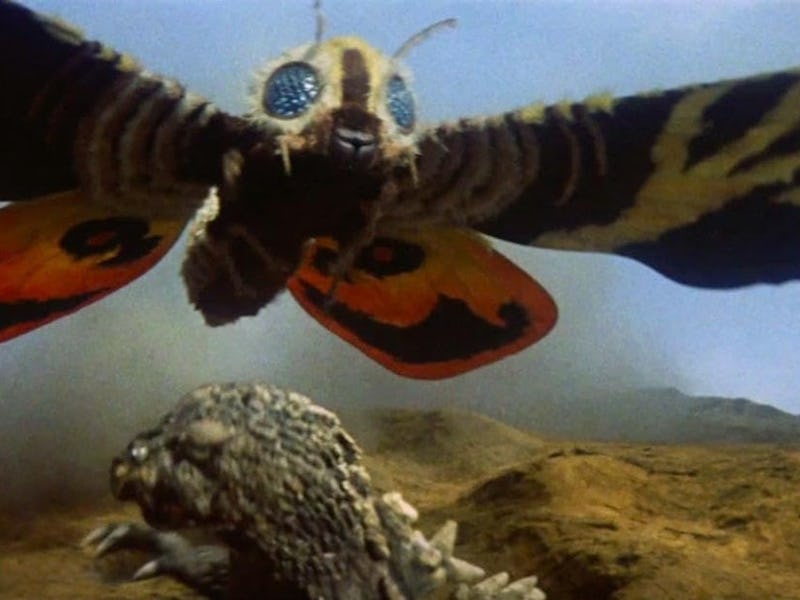Remember When Toho’s MonsterVerse Took on the Patriarchy?
Mothra vs. Godzilla pit two unlikely kaiju against each other, and it changed the franchise for the better.

Is it silly to search for feminist themes within a kaiju film? Maybe a little, as your average take on such franchises as Godzilla doesn’t often go beyond surface level. That said, films like Godzilla Minus One serve as a reminder of how deep a monster film can really be. The 2023 film brought its titular kaiju back to its role as a fierce, and terrifying, metaphor — but it also reenforced the machismo themes that have always dominated the saga.
Godzilla was not always a “good guy,” nor was he the reluctant protector of the innocent. For decades after his first outing in Ishirō Honda’s first Godzilla, he served as an incarnation of Japan’s nuclear trauma. The King of the Monsters has always met violence with violence, and in his early films, he was a cut-and-dry antagonist, if not a villain outright. It wasn’t until Ghidorah, the Three-Headed Monster, released in 1964, that Godzilla truly became the hero most know and love today. But before that, Godzilla played the bad guy for the last time... and inadvertently paved the way for a feminist icon.
Naturally, we’re talking about Mothra. Known now as the queen to Godzilla’s king, Mothra was ostensibly a kaiju for the girls when she was introduced in the ‘60s. Her debut in Mothra felt like a playful antithesis to Godzilla’s first film, exploring the same beats as a “monsters attack!” movie, but subverting the themes to appeal to a new demographic. Mothra is capable of as much destruction as ‘Zilla, but her role as the defender of nature — and as a steward of divine femininity — takes precedence. She never inflicts violence outright, though when she does, the people in her crosshairs tend to deserve it.
That’s basically the premise of Mothra vs. Godzilla, the 1964 film that brought these crazy kaiju together for the first time. The crossover was a product of two prior successes: Mothra itself, and Godzilla’s last appearance in Godzilla vs. King Kong. And in a lot of ways, it’s basically a retread of both. But something changes when you pit the progenitor of ruin against a benevolent symbol of peace. Not only does Mothra vs. Godzilla serve as a spectacular takedown of capitalism and greed, but it’s also the first to suggest that Godzilla’s indiscriminate aggression might be getting old.
Mothra vs. Godzilla is a direct follow-up to the events of Mothra, but it’s not too difficult to follow the film otherwise. Mothra is basically the guardian of a mythical island nation, but she hasn’t been seen for years — and when one of her eggs washes up in Japan after a typhoon, it’s quickly acquired by an opportunistic capitalist. Naturally, he wants to turn the massive egg into a theme park attraction, and Mothra’s allies are powerless to stop him.
Complicating matters further is the reappearance of Godzilla, who promptly sets off to destroy Mothra’s egg because... it’s a threat somehow? As countless kaiju films have proven, there can really only be one big monster stomping around at a time — but the fact that ‘Zilla would try to hurt an unborn moth baby feels like a bridge too far.
Just as Godzilla came to represent destruction, Mothra became synonymous with life, making the two monsters a perfect pair.
Fortunately Mothra intercedes, stopping Godzilla before he can enact any senseless violence. Their clash represents a shift in priorities for Toho, who until then hadn’t changed much about Godzilla. In the years following his first film, Godzilla’s role made a lot of sense. Japan and its filmmakers were still working out ways to express the fear of nuclear annihilation, and at the time, Godzilla served both as a reminder of that and the embodiment of unflinching moral judgement.
That changed as he appeared in subsequent films, eventually crossing over to the West. Godzilla’s unbridled rage and frequent tantrums started to feel repetitive; it seemed like Honda and his collaborators were ready to move on.
Enter Mothra, a figure that represents forgiveness, peace, and a much-needed ego check for Godzilla. Though (spoilers) she doesn’t survive her first altercation with the King of the Monsters, her sacrifice does allow her egg to hatch, and two baby Mothras to emerge. Ironically, it’s her children that defeat Godzilla and send him packing. When the dust settles, Japan brokers an alliance with Infant Island — the nation that Mothra serves as guardian of — in the pursuit of lasting peace.
Mothra vs. Godzilla doesn’t spend much time on the titular clash, but its effects on the franchise are still pretty tangible.
Mothra has always represented rebirth, but in Mothra vs. Godzilla, she also demonstrates a more sustainable way forward. War and revenge are most commonly associated with masculinity, making Godzilla a potent symbol of both. Mothra’s brand of justice is very different, almost passive, but just as potent — and sure, it might not be as realistic, but the same could be said for any aspect of these films (aside from the greedy venture capitalists).
In a roundabout way, this is why Mothra’s most commonly associated with Godzilla. Her impact on the latter wouldn’t be seen until Ghidorah (which premiered just a few months after Mothra vs. Godzilla), but Godzilla was a changed monster after his first brush with Mothra. Mothra vs. Godzilla is a stellar example of a subtle rebrand, but it’s also one of Toho’s best films. Sixty years later, its affects on the Monsterverse are myriad: we likely wouldn’t have Godzilla the Defender without Mothra.